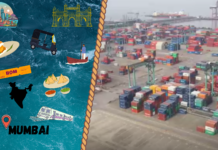
Shipping lines have been creating services in the Indian sub-continent and the Middle East as these regions are now creating hubs for manufacturers, and there is the infrastructure to support ocean transport, according to Container xChange’s latest monthly report.
Amid rising geopolitical tensions between the US and China, manufacturers have been diversifying their production bases away from China and to other regions, such as the Indian subcontinent and Southeast Asia.
Recently, COSCO Shipping Ports announced the US$375 million purchase of a 25% stake in Egypt’s Sokhna New Container Terminal. The project will operate for 30 years. It is believed that once complete, the terminal’s container capacity will reach 1.7 million TEU.
In addition, French carrier CMA CGM announced the launch of the new Bangladesh India Gulf Express (BIGEX) service, which began sailing from the port of Chittagong on 5 April, and will offer Bangladesh and India a direct connection with the Persian Gulf. The transit times will be much faster and exports from Chittagong will reach Nhava Sheva and Mundra within 10 days and Jebel Ali and Abu Dhabi within 15 days.
Container xChange also noted that Maersk Line integrated two emerging markets – West & Central Asia and Africa – to form a new combined IMEA (Indian sub-continent, Middle East and Africa) region. The primary markets for this new region will be India, Pakistan, the UAE, Saudi Arabia, South Africa, Kenya, Ivory Coast, Cameroon, Nigeria, Senegal, and Ghana, among others.
Maersk clarified that its customers would continue to work with the same teams and that the products and solutions they are offered will stay the same until informed otherwise.
The Indian sub-continent and the Middle East are thus not just viable regions thriving in resources but also strategic locations. The regions are now creating hubs for manufacturers, building infrastructure to support ocean and air transport, and actively making consumer markets more compact. Evidently, global supply chains are now getting more efficient with better accessibility and higher potential.
Martina Li
Asia Correspondent





